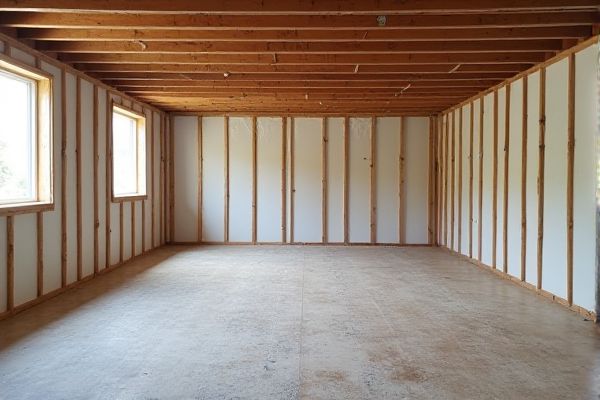
Spray foam insulation offers superior air sealing and moisture resistance compared to fiberglass insulation, making it highly effective for basement environments prone to dampness. To discover which insulation type best suits your basement needs, continue reading the full article.
Table of Comparison
| Feature | Spray Foam Insulation | Fiberglass Insulation |
|---|---|---|
| R-Value (Thermal Resistance) | 6.0 to 7.0 per inch (Closed-cell) | 2.2 to 3.8 per inch |
| Moisture Resistance | High (Closed-cell acts as vapor barrier) | Low (Prone to moisture absorption) |
| Air Sealing | Excellent (Seals cracks and gaps) | Poor (Leaves air gaps) |
| Installation Complexity | Professional required | DIY possible |
| Durability | Long-lasting, resists settling and decay | Can compress and degrade over time |
| Cost | Higher upfront cost | Lower upfront cost |
| Soundproofing | Good | Moderate |
| Mold Resistance | Resists mold growth | Susceptible to mold if wet |
| Environmental Impact | Uses chemicals, some types have higher GWP | Made from glass fibers, recyclable |
Introduction to Basement Insulation Options
Spray foam insulation and fiberglass insulation are two popular choices for basement insulation, each offering distinct thermal performance and moisture resistance properties. Spray foam insulation provides superior air sealing and higher R-values per inch, making it ideal for preventing heat loss and minimizing mold growth in damp basement environments. Fiberglass insulation is cost-effective and easy to install but may require additional vapor barriers to protect against moisture and reduce potential mold issues in basements.
What is Spray Foam Insulation?
Spray foam insulation is a highly effective insulating material composed of polyurethane that expands upon application to fill gaps and create an airtight seal in basement walls and cavities. It provides superior thermal resistance with an R-value ranging from 6 to 7 per inch, significantly reducing heat loss and moisture infiltration compared to traditional fiberglass insulation. This insulation method also acts as a barrier against air leaks and mold growth, enhancing energy efficiency and indoor air quality in basements.
What is Fiberglass Insulation?
Fiberglass insulation, made from fine glass fibers, is commonly used in basements to reduce heat loss and improve energy efficiency. This material is available in batts or loose-fill forms and excels at fitting between wall studs and joists, providing soundproofing and thermal resistance. Your basement's comfort and energy bills can benefit significantly from proper fiberglass insulation due to its affordability and ease of installation.
Installation Process: Spray Foam vs Fiberglass
Spray foam insulation for basements involves a professional application using high-pressure spray equipment that expands to fill cracks and gaps, creating an airtight seal and superior moisture resistance. Fiberglass insulation installation is a manual process that requires cutting batts or rolls to fit between basement studs, with potential gaps and compression reducing its effectiveness. Spray foam's expansion and adhesion offer a more seamless barrier compared to fiberglass, which can suffer from sagging and limited sealing capabilities.
Energy Efficiency Comparison
Spray foam insulation offers superior energy efficiency in basements due to its high R-value per inch, typically around R-6 to R-7, and its ability to create an airtight seal that minimizes heat loss and prevents air infiltration. Fiberglass insulation, with an R-value of approximately R-2.2 to R-2.7 per inch, often allows air gaps and moisture penetration, reducing its overall thermal performance and leading to higher energy costs. The airtight barrier provided by spray foam reduces heating and cooling loads, making it a more cost-effective solution for long-term energy savings in basement applications.
Moisture and Mold Resistance
Spray foam insulation offers superior moisture and mold resistance compared to fiberglass insulation in basements due to its ability to create an airtight seal that prevents water infiltration. Fiberglass insulation tends to absorb moisture, leading to mold growth and reduced insulating effectiveness. Choosing spray foam helps protect your basement from dampness and mold-related issues, ensuring a healthier indoor environment.
Cost Analysis: Spray Foam vs Fiberglass
Spray foam insulation typically costs between $1.50 and $3.00 per square foot, offering superior air sealing and higher R-values compared to fiberglass insulation, which ranges from $0.50 to $1.50 per square foot. While spray foam's upfront investment is higher, its energy efficiency can reduce heating and cooling costs by up to 30% in basement applications. Fiberglass insulation, although more affordable initially, may result in increased energy expenses due to lower thermal performance and potential moisture issues in basements.
Longevity and Maintenance
Spray foam insulation offers superior longevity in basements due to its resistance to moisture, mold, and air leaks, ensuring a long-lasting thermal barrier with minimal maintenance. Fiberglass insulation, while initially cost-effective, tends to degrade over time when exposed to humidity, leading to reduced effectiveness and frequent replacement or upkeep. Choosing spray foam can save you time and money on maintenance while providing consistent insulation performance over the years.
Health and Environmental Impact
Spray foam insulation reduces air infiltration and moisture buildup, limiting mold growth and improving indoor air quality compared to fiberglass insulation, which can release microscopic fibers that may irritate respiratory systems. Made from polyurethane, spray foam has a higher global warming potential during production, but its superior energy efficiency lowers overall carbon emissions throughout its lifespan. Fiberglass insulation is often made from recycled glass and sand, making it more environmentally friendly initially, yet its susceptibility to moisture can lead to decreased performance and increased waste.
Which Insulation is Best for Your Basement?
Spray foam insulation offers superior air sealing and moisture resistance, making it ideal for basement environments prone to humidity and temperature fluctuations. Fiberglass insulation is more cost-effective but less efficient at preventing air leaks and can be susceptible to mold if moisture penetrates. Choose spray foam if you want enhanced energy efficiency and durability for your basement, while fiberglass suits budget-friendly projects with less moisture concern.
 homyna.com
homyna.com